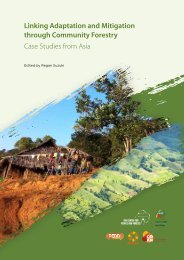Desktop Study on - Regional Climate Change Adaptation ...
Desktop Study on - Regional Climate Change Adaptation ...
Desktop Study on - Regional Climate Change Adaptation ...
Create successful ePaper yourself
Turn your PDF publications into a flip-book with our unique Google optimized e-Paper software.
Assessment of Capacity Gaps and Needs of South East Asia Countries<br />
in Addressing Impacts, Vulnerability and Adaptati<strong>on</strong> to <strong>Climate</strong> Variability and <strong>Climate</strong> <strong>Change</strong><br />
AND CHALLENGES<br />
The projected exposure to climate change impacts<br />
seems relatively less severe in Cambodia than that<br />
of other countries (Roth, 2009). However, taking<br />
into c<strong>on</strong>siderati<strong>on</strong>, vulnerability to climate change<br />
as a result of not <strong>on</strong>ly exposure but also adaptive<br />
capacity, the country still remains highly vulnerable<br />
with its relatively lower level of adaptive capacity<br />
(Yusuf and Francisco, 2009 cited in Roth, 2009).<br />
Water Sector<br />
There is lack of knowledge that supports an<br />
appropriate operati<strong>on</strong>al scheme such as real-time<br />
informati<strong>on</strong> about rainfall and water level, flood<br />
forecasts in the wet seas<strong>on</strong> (Watt, 2009 cited in<br />
Solar, 2009). On the other hand, there is still an issue<br />
of uncertainty related to the existing projecti<strong>on</strong>s<br />
of climate change impacts, which dem<strong>on</strong>strates<br />
different informati<strong>on</strong> <strong>on</strong> climatic variability for<br />
different timescales (TKK, SEA START RC and<br />
RUPP, 2009). Due to str<strong>on</strong>g seas<strong>on</strong>al and interannual<br />
variati<strong>on</strong> of the water regime in the Mek<strong>on</strong>g<br />
floodplains and the Tônlé Sap Lake, it is indicated as<br />
more important to reflect <strong>on</strong> changes in extremes,<br />
for example, of highest water levels, rather than<br />
expected average figure. Moreover, there is a<br />
need for more holistic approach to climate change<br />
impacts and adaptati<strong>on</strong> that integrates broader<br />
socio-ec<strong>on</strong>omic, instituti<strong>on</strong>al and political c<strong>on</strong>texts<br />
and different temporal and geographic scales (ibid).<br />
It is estimated, for example, that relatively radical<br />
changes to the Tônlé Sap flood pulse system are<br />
predicted to occur in more immediate timescale due<br />
to upstream hydropower development rather than<br />
climate change.<br />
In additi<strong>on</strong>, not much research and evaluati<strong>on</strong> of the<br />
groundwater resources of the Mek<strong>on</strong>g Basin have<br />
been c<strong>on</strong>ducted including the volume, discharge/<br />
recharge rate and different use of groundwater and<br />
sources, distributi<strong>on</strong> and impacts of groundwater<br />
c<strong>on</strong>taminati<strong>on</strong> (Eastham et al., 2008). In order to<br />
assess impacts of the current and projected climate<br />
change c<strong>on</strong>diti<strong>on</strong>s <strong>on</strong> the groundwater resources<br />
in various countries of the Mek<strong>on</strong>g River regi<strong>on</strong>,<br />
it is required to develop regi<strong>on</strong>al models of the<br />
groundwater systems that allow quantificati<strong>on</strong><br />
of the groundwater resources (ibid). This entails<br />
the detailed hydrogeological and geophysical<br />
investigati<strong>on</strong>s of the aquifer systems in various<br />
countries and regi<strong>on</strong>s of the Mek<strong>on</strong>g Basin as well as<br />
the groundwater m<strong>on</strong>itoring network.<br />
Agriculture and Food Security Sector<br />
The strategies to intensify and/or sustain agricultural<br />
productivity in Cambodia are often suggested as an<br />
adaptati<strong>on</strong> measure. However, the strategies are not<br />
being driven by climatic impacts, but to a greater<br />
extent by the inflow of foreign investment for the<br />
purpose of extracting land c<strong>on</strong>cessi<strong>on</strong>s for largescale<br />
agricultural enterprises (Roth, 2009). The<br />
increasing demand for agricultural products from<br />
neighbouring countries, such as, Thailand and Viet<br />
Nam are also a determinant factor of the changes<br />
in agricultural practices. These drivers could serve<br />
as an opportunity, if aligned with climate change<br />
adaptati<strong>on</strong> needs, and could prove to be an effective<br />
mechanism, if adaptated . This would require a policy<br />
research that provides recommendati<strong>on</strong>s <strong>on</strong> how<br />
best to mainstream the climate adaptati<strong>on</strong> agenda<br />
into the broader development policies of Cambodia<br />
(Roth, 2009).<br />
Instituti<strong>on</strong>al Settings c<strong>on</strong>cerning <strong>Climate</strong><br />
<strong>Change</strong><br />
Integrati<strong>on</strong> of climate change adaptati<strong>on</strong> issues<br />
into nati<strong>on</strong>al policies and programmes as well as<br />
awareness of the climate change issues are limited<br />
to agricultural and water resources sector (Solar,<br />
2009). The approaches toward the disaster risk<br />
reducti<strong>on</strong> would be an appropriate entry point for<br />
certain actors to assess, negotiate and prioritise<br />
initiatives, leading to integrati<strong>on</strong> of climate change<br />
adaptati<strong>on</strong> issues across all the sectors.<br />
There are technical gaps <strong>on</strong> data management<br />
am<strong>on</strong>g nati<strong>on</strong>al bodies. Quality climate data that<br />
have been collected, for example, by Department<br />
of Meteorology (DoM) are not digitised, and hence,<br />
CCCO cannot utilise them for the development of the<br />
Sec<strong>on</strong>d Nati<strong>on</strong>al Communicati<strong>on</strong> or the DoM cannot<br />
enhance their observati<strong>on</strong> capacities to c<strong>on</strong>duct<br />
better climate change projecti<strong>on</strong>s (Solar, 2009).<br />
There remains a challenge <strong>on</strong> applicati<strong>on</strong>s of climate<br />
modelling. For example, the system of climate<br />
modelling is not applicable and user-friendly, and<br />
not integrating hydrological features required by<br />
the Ministry of Water Resources and Meteorology<br />
(MoWRAM) and the Ministry of Agriculture, Forests,<br />
and Fisheries (MAFF). Also, knowledge and system<br />
of climate modelling are not brought to the ground<br />
level, and hence, farmers cannot adjust their initiative<br />
in accordance to climate events (Solar, 2009). In<br />
order to address this challenge, it is suggested that<br />
the NCCC establish a detailed integrated process of<br />
data gathering and analysis as well as disseminati<strong>on</strong><br />
of data to c<strong>on</strong>cerned groups and incorporate the<br />
121

















